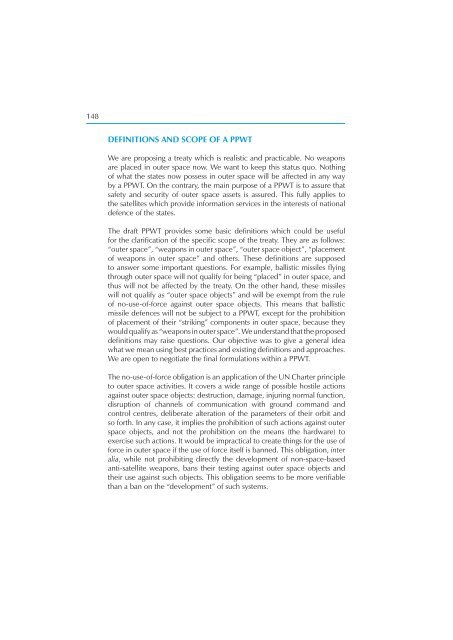Security in Space The Next Generation - UNIDIR
Security in Space The Next Generation - UNIDIR
Security in Space The Next Generation - UNIDIR
You also want an ePaper? Increase the reach of your titles
YUMPU automatically turns print PDFs into web optimized ePapers that Google loves.
148<br />
DEFINITIONS AND SCOPE OF A PPWT<br />
We are propos<strong>in</strong>g a treaty which is realistic and practicable. No weapons<br />
are placed <strong>in</strong> outer space now. We want to keep this status quo. Noth<strong>in</strong>g<br />
of what the states now possess <strong>in</strong> outer space will be affected <strong>in</strong> any way<br />
by a PPWT. On the contrary, the ma<strong>in</strong> purpose of a PPWT is to assure that<br />
safety and security of outer space assets is assured. This fully applies to<br />
the satellites which provide <strong>in</strong>formation services <strong>in</strong> the <strong>in</strong>terests of national<br />
defence of the states.<br />
<strong>The</strong> draft PPWT provides some basic defi nitions which could be useful<br />
for the clarifi cation of the specifi c scope of the treaty. <strong>The</strong>y are as follows:<br />
“outer space”, “weapons <strong>in</strong> outer space”, “outer space object”, “placement<br />
of weapons <strong>in</strong> outer space” and others. <strong>The</strong>se defi nitions are supposed<br />
to answer some important questions. For example, ballistic missiles fl y<strong>in</strong>g<br />
through outer space will not qualify for be<strong>in</strong>g “placed” <strong>in</strong> outer space, and<br />
thus will not be affected by the treaty. On the other hand, these missiles<br />
will not qualify as “outer space objects” and will be exempt from the rule<br />
of no-use-of-force aga<strong>in</strong>st outer space objects. This means that ballistic<br />
missile defences will not be subject to a PPWT, except for the prohibition<br />
of placement of their “strik<strong>in</strong>g” components <strong>in</strong> outer space, because they<br />
would qualify as “weapons <strong>in</strong> outer space”. We understand that the proposed<br />
defi nitions may raise questions. Our objective was to give a general idea<br />
what we mean us<strong>in</strong>g best practices and exist<strong>in</strong>g defi nitions and approaches.<br />
We are open to negotiate the fi nal formulations with<strong>in</strong> a PPWT.<br />
<strong>The</strong> no-use-of-force obligation is an application of the UN Charter pr<strong>in</strong>ciple<br />
to outer space activities. It covers a wide range of possible hostile actions<br />
aga<strong>in</strong>st outer space objects: destruction, damage, <strong>in</strong>jur<strong>in</strong>g normal function,<br />
disruption of channels of communication with ground command and<br />
control centres, deliberate alteration of the parameters of their orbit and<br />
so forth. In any case, it implies the prohibition of such actions aga<strong>in</strong>st outer<br />
space objects, and not the prohibition on the means (the hardware) to<br />
exercise such actions. It would be impractical to create th<strong>in</strong>gs for the use of<br />
force <strong>in</strong> outer space if the use of force itself is banned. This obligation, <strong>in</strong>ter<br />
alia, while not prohibit<strong>in</strong>g directly the development of non-space-based<br />
anti-satellite weapons, bans their test<strong>in</strong>g aga<strong>in</strong>st outer space objects and<br />
their use aga<strong>in</strong>st such objects. This obligation seems to be more verifi able<br />
than a ban on the “development” of such systems.








